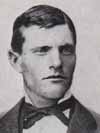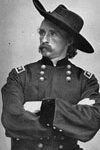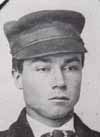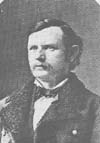 James Madison DeWolf (left) was born in Mehonpany, Pennsylvania, on January 14, 1843. He was the Acting Assistant Surgeon for the Seventh, and he was killed during the battle.
James Madison DeWolf (left) was born in Mehonpany, Pennsylvania, on January 14, 1843. He was the Acting Assistant Surgeon for the Seventh, and he was killed during the battle.
 Thomas F. O’Neill (right) was born on January 14, 1846 (gravestone has 1847) in Dublin, Ireland. He was a Private with Company G who participated in the valley and hilltop fights.
Thomas F. O’Neill (right) was born on January 14, 1846 (gravestone has 1847) in Dublin, Ireland. He was a Private with Company G who participated in the valley and hilltop fights.
Andrew Fredericks died on January 14, 1881, at Fort Totten, Dakota Territory, and was buried in the Custer National Cemetery on Crow Agency, Montana. He was a Sergeant in Company K who fought on the hilltop.
 Charles Braden (left) died on January 15, 1919, in Highland Falls, New York, and was buried at the U.S. Military Academy Post Cemetery. He was an 1869 graduate of the Academy who married Jeanette Devin, the daughter of General Thomas Casimer Devin, who was said to be one of the best and most effective Union commanders in the Civil War. Braden was not present at the Battle of the Little Bighorn due to wounds suffered during an Indian attack on his camp on the Yellowstone River on August 11, 1873. He was granted a leave of absence on March 13, 1874, until he retired due to disability on June 28, 1878.
Charles Braden (left) died on January 15, 1919, in Highland Falls, New York, and was buried at the U.S. Military Academy Post Cemetery. He was an 1869 graduate of the Academy who married Jeanette Devin, the daughter of General Thomas Casimer Devin, who was said to be one of the best and most effective Union commanders in the Civil War. Braden was not present at the Battle of the Little Bighorn due to wounds suffered during an Indian attack on his camp on the Yellowstone River on August 11, 1873. He was granted a leave of absence on March 13, 1874, until he retired due to disability on June 28, 1878.
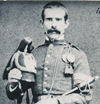 Fremont Kipp (right) died in Washington, D.C., on January 16, 1938, and was buried there in the Soldiers’ Home National Cemetery. He was a Private in Company D who participated in the hilltop fight.
Fremont Kipp (right) died in Washington, D.C., on January 16, 1938, and was buried there in the Soldiers’ Home National Cemetery. He was a Private in Company D who participated in the hilltop fight.
Young Hawk died on January 16, 1915, in Elbowoods, North Dakota, and was buried in the Indian Scout Cemetery in McLean County, North Dakota. He was an Arikara scout who participated in the valley and hilltop fights.
Francis Hegner died in Kenockee Township, Michigan, on January 17, 1891. He was a Private in Company F who was on detached service during the battle, so he was not present.
 Francis Marion Gibson (left) died on January 17, 1919, in New York City and was buried at Arlington National Cemetery. He was the brother-in-law of Donald McIntosh. He was the First Lieutenant of Company H who was on scouting duty and participated in the hilltop fight.
Francis Marion Gibson (left) died on January 17, 1919, in New York City and was buried at Arlington National Cemetery. He was the brother-in-law of Donald McIntosh. He was the First Lieutenant of Company H who was on scouting duty and participated in the hilltop fight.
Joseph Carroll was born in New York, New York, on January 19, 1847. He was a member of the band, so he was not present at the battle.
 John E. Hammon (right) died on January 19, 1909, in Sturgis, South Dakota, and was buried there in the Bear Butte Cemetery. He was a Corporal in Company G and was in the hilltop and valley fights.
John E. Hammon (right) died on January 19, 1909, in Sturgis, South Dakota, and was buried there in the Bear Butte Cemetery. He was a Corporal in Company G and was in the hilltop and valley fights.
Henry Harrison Davis was born on January 20, 1846, in Bellvernon, Virginia. He was a Private in Company M and was in the hilltop and valley fights. He died around 1905.
John J. Rafter was born in Lansingburgh, New York, on January 20, 1851, and died on January 16, 1927, in Leavenworth, Kansas. He was buried in the Mount Calvary Cemetery in Leavenworth. He was the Sergeant in Company K who was with the pack train and participated in the hilltop fight.
August B. Siefert died on January 20, 1921, in Highland Park, Illinois, and was buried in the Fort Sheridan Cemetery in Highwood, Illinois. He was a Private with Company K during the hilltop fight.
